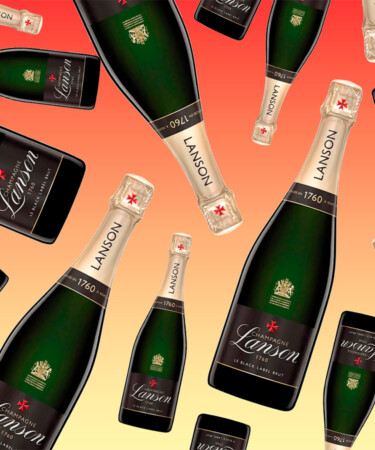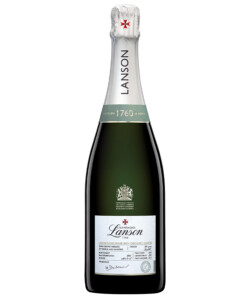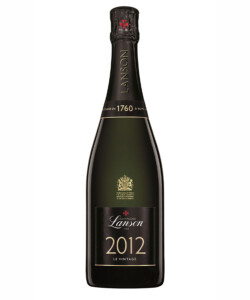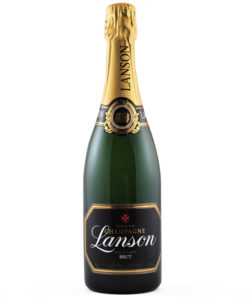With roots tracing all the way back to 1760, Champagne Lanson is one of the oldest Champagne houses in existence. After its founding by bourgeois militia captain and vineyard owner François Delamotte, the house was taken over by close friend and business partner Jean-Baptiste Lanson and renamed Champagne Lanson.
With Lanson at the helm, the business developed rapidly under its new title, especially in markets outside France. Today, the Champagne house remains committed to its four foundational pillars when producing wines: a meticulous selection of crus, vinification according to the original principle of Champagne, a rare collection of reserve wines, and prolonged maturation in cellars.
Now that you know the basics, here are nine more things you should know about Champagne Lanson.
-
The signature cross on every bottle of Champagne Lanson dates back to the 11th century.
Each bottle of Champagne Lanson comes embossed with a scarlet red cross on the label, a significant symbol in the Catholic Church. The Maltese Cross originally belonged to the Order of Malta, a religious order of which François Delamotte’s youngest son, Nicolas-Louis, was a member. He was forced to leave Malta and return to France in 1798 following Napoleon Bonaparte’s expulsion of the order and subsequent French occupation of the island. Nicolas-Louis then took control of the Champagne house and made the decision to use the Maltese Cross as the emblem as a symbol of openness, kindness, and hospitality.
-
The house prides itself on its vast presence in foreign markets.
A key aspect of Champagne Lanson is its focus on exporting to foreign markets, a priority the brand has maintained since the 1830s. When Lanson took charge of the house in 1837 following the death of Nicolas-Louis, he quickly got to work on developing the Champagne’s reach in markets outside France, particularly those in Great Britain. It was a business strategy he passed onto his son, Victor-Marie, who took charge of the house in 1855 and signed the first exclusive agent’s agreement with the Percy Fox company in London, ensuring that Champagne Lanson was the only French bubbly to be sold by the wine and spirits retailer. The agreement, which lasted for over 100 years, solidified Lanson’s popularity across the English channel.
-
The Champagne is beloved by royals.
Given the Champagne’s dominant position in the United Kingdom, it was only a matter of time before the royals got their hands on it. In fact, Champagne Lanson has been an official supplier of Champagne to the British royal court since 1900 when Queen Victoria awarded the title of Purveyor of Champagne to Her Majesty to Henri Marie Lanson. To this day, the Royal Seal appears on every bottle of Champagne Lanson, though now that King Charles has assumed the throne, Lanson will have to reapply to continue embossing its bottles with the crest. But it wasn’t just the British monarchy the brand managed to impress over the years: Champagne Lanson has also previously received royal appointments to the courts of Sweden and Spain.
-
The brand is the official Champagne of Wimbledon.
Since the 1970s, Champagne Lanson has been a partner to the All England Lawn Tennis & Croquet Club (a.k.a. All England Club), home to the annual Wimbledon tennis tournament. Since the partnership began in 1977, it’s estimated that approximately 4 million glasses of Lanson have been poured at the tennis championship. In 2001, the Champagne house finally became the official Champagne of Wimbledon. Though the partnership was set to expire in 2023, the Champagne house and the tennis club have renewed their partnership, which is now set to expire in 2028.
-
During World War I, Champagne Lanson’s cellars housed hundreds of refugees.
Both World War I and World War II wreaked havoc on the Champagne region, as vineyards were transformed into battlefields. During the former, the city of Reims was a specific target for German bombings, with near-constant shelling of the Reims Cathedral. To support the community, Champagne Lanson opened the doors to its underground cellars where many townspeople took refuge. Beds, tables, and chairs were provided in the cellar for those seeking refuge, and temporary schools and churches were assembled in order to preserve some semblance of life above ground. According to Forbes, there were even weddings that took place at the underground church as the cathedral above ground continued to be destroyed. Today, many growers who supply Champagne Lanson with grapes are descendants of those who lived in the cellars during the war.
-
Malolactic fermentation takes a backseat during production.
One of the core pillars of Champagne Lanson’s philosophy is to produce Champagne with vinification techniques according to the original principle of the region, which involves a non-malolactic style of fermentation. During malolactic fermentation (MLF), tart malic acid is converted to lactic acid, resulting in a softer Champagne with less fruit flavor and more creamy butter notes. Of the dozens of wines produced at Champagne Lanson, the only wine that undergoes malolactic fermentation is the flagship Black Label. And even then, only 20 to 25 percent of the wine is converted, staying true to the brand’s traditional production methods. By straying away from malolactic fermentation, Lanson’s Champagnes are able to age in-bottle for years longer than Champagnes containing an abundance of lactic acid.
-
The house’s wines undergo a much longer aging period than the Champagne region deems necessary.
As Champagne Lanson wines have not undergone MLF, they’re able to undergo a longer aging process than other houses in the region. While the Champagne region denotes that wine must age in its bottle for at least 15 months and on the lees for at least 12, Black Label NV ages on the lees for at least four years before it is disgorged. As the wines do not undergo any malolactic fermentation, the longer aging period allows for the wines to naturally soften, rounding out any of the too-harsh acidity remaining from the malic acid.
-
Champagne Lanson has a massive selection of reserve wines used for blending.
The cellars at Champagne Lanson hold a collection of vintage Champagnes dating all the way back to 1904. The collection was started in 1967 by Etienne Lanson, the man in charge of the house at the time, who aspired to conserve previous vintages the house could use for blending in the future. In the brand’s core selection — Black Label, White Label, and Rosé — 35 percent of the wine consists of reserve vintages that potentially date as far back as 2006. In addition to using these wines for blending, in recent years, Champagne Lanson has started to sell a few vintages per annum, most of which are bottled in Magnum.
-
The House is making serious strides to become more sustainable.
As climate change has risen to the forefront of public consciousness, Champagne Lanson has made significant attempts to increase its sustainability efforts. The house maintains a 16-acre plot of land at the heart of the Vallée de la Marne that’s exclusively focused on cultivation using innovative and respectful viticulture. The entire vineyard, which is certified organic and biodynamic, is one of the largest biodynamically farmed plots of land in the Champagne region, and is where 100 percent of the grapes are sourced for the brand’s Le Green Label. Consisting of 46 percent Pinot Noir, 36 percent Chardonnay, and 18 percent Pinot Meunier, the wine delivers deep golden apple and toast aromas with refreshing acidity and vivacious bubbles.



